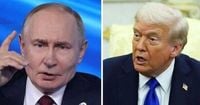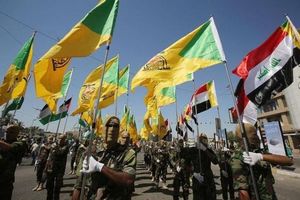As tensions continue to mount between Russia and the West, the world watched with apprehension this past weekend as a series of dramatic threats and warnings were exchanged between the United States, Russia, and Ukraine. The latest escalation centers on U.S. President Donald Trump’s public suggestion that the United States might supply Ukraine with Tomahawk cruise missiles—a move that has rattled Moscow and drawn strong rebukes from Russian officials, while simultaneously fueling anxiety across Europe about the prospect of a wider conflict.
On Sunday, October 12, 2025, President Trump, speaking to reporters aboard Air Force One en route to Israel, made a statement that reverberated far beyond the aircraft cabin. "I might say, look, if this war is not going to get settled, I’m going to send them Tomahawks," Trump declared, referencing the ongoing conflict between Russia and Ukraine. He went on to describe the Tomahawk as "an incredible weapon, very offensive weapon. And honestly, Russia does not need that." Trump added, "We may not, but we may do it. I think it’s appropriate to bring up." According to LADbible and The Express, the president’s remarks followed a conversation with Ukrainian President Volodymyr Zelenskyy, who has been pushing for stronger military support from Washington.
The Tomahawk cruise missile is no ordinary piece of hardware. With a range of up to 1,550 miles and a warhead weighing nearly half a ton, these missiles represent a significant step up in firepower compared to any weapons previously supplied to Kyiv by the West. The U.S. military has used Tomahawks in past conflicts, including strikes on Iranian nuclear facilities earlier this year, as reported by Daily Express. Their long reach and potential nuclear capability make them a highly sensitive subject in the context of the Russia-Ukraine war.
Trump’s willingness to escalate U.S. involvement in Ukraine was not without caveats. He admitted that delivering Tomahawks would be "a new step of aggression" and acknowledged the risk of triggering further escalation. "Do they want to have Tomahawks going in that direction? I don’t think so," Trump said, referring to Russia. "I think I might speak to Russia about that." He also emphasized that any such move would be aimed at compelling Moscow to resolve the conflict, rather than an immediate decision.
The response from Moscow was swift and severe. Dmitri Medvedev, former Russian president and a close ally of Vladimir Putin, issued a stark warning via Telegram: "Trump said that if the Russian President doesn't resolve the Ukrainian conflict, 'it will end badly for him.' He's making this threat for the hundred and first time, in short. If the 'business peacemaker' is referring to Tomahawks, the phrase is incorrect. The delivery of these missiles could end badly for everyone. And most of all, for Trump himself." Medvedev went further, suggesting that Russia would interpret any missile launch from Ukraine as an attack by the United States, potentially leading to a much wider conflict. "It's been said a hundred times, in a manner understandable even to the star-spangled man, that it's impossible to distinguish a nuclear Tomahawk from a conventional one in flight. It won't be Bandera's Kyiv that launches them, but the United States. Read: Trump. How to respond to Russia? Exactly!" he wrote, as reported by The Express.
Kremlin spokesperson Dmitry Peskov also weighed in, warning that the world was facing a "very dramatic moment" as tensions escalated from all sides. "Just imagine: a long-range missile is launched and is flying and we know that it could be nuclear. What should the Russian Federation think? Just how should Russia react? Military experts overseas should understand this," Peskov told Daily Express. Russian state TV host Vladimir Solovyov even compared the transfer of Tomahawks to the Cuban Missile Crisis of 1962, warning of the potential for catastrophic consequences.
Ukrainian President Volodymyr Zelenskyy, for his part, welcomed the prospect of increased U.S. support. In his nightly address, Zelenskyy said, "We see and hear that Russia fears the possibility of the United States providing us with Tomahawks. It is a signal that this kind of pressure can be effective in achieving peace. President Trump and I agreed that our teams and our military will be working on all the matters we discussed." He also assured Western audiences that Ukraine would use any long-range missiles solely on Russian military targets, not civilians. "We never attacked their civilians. This is the big difference between Ukraine and Russia," Zelenskyy told Fox News. "That’s why, if we speak about long-range [missiles], we speak only about military goals."
This high-stakes exchange comes against the backdrop of what analysts are calling Russia’s "Phase Zero" in a shadow war against NATO and the West. According to the Institute for the Study of War (ISW), Moscow is now engaged in an "informational and psychological condition-setting phase"—laying the groundwork for potential future conflict with the Alliance. This phase involves a mix of espionage, sabotage, drone incursions, and the appearance of unmarked troops, sometimes referred to as "little green men." As reported by The Sun, Estonia recently closed a section of its border after seven unidentified armed men in unmarked uniforms were spotted near the "Saatse Boot," a strip of Russian territory cutting through Estonia. The incident, the first sighting of such operatives near a NATO frontier in this campaign, prompted immediate concern about possible provocations or escalation.
Europe has also been hit by a wave of hybrid attacks in recent weeks, including mysterious drone flights over military bases, fighter jet incursions into NATO skies, coordinated sabotage, and crippling cyberstrikes. Airports in Denmark, Poland, and Romania have faced repeated drone incursions, and a massive ransomware attack recently paralyzed major European airports, forcing airlines to revert to pen-and-paper check-ins. British Defence Minister John Healey highlighted NATO unity in the face of these provocations, stating, "Not only does this provide valuable intelligence to boost the operational awareness of our Armed Forces, but sends a powerful message of NATO unity to Putin and our adversaries."
Meanwhile, Ukraine has been striking back with its own long-range drone campaign, targeting Russian oil refineries and causing fuel shortages and price spikes inside Russia. U.S. intelligence support has been vital to these operations, and the possibility of Tomahawk missiles entering the picture has only added to the Kremlin’s alarm. Russian officials have tried to downplay the impact of such weapons, but the flurry of diplomatic and military activity suggests deep concern in Moscow about the evolving balance on the battlefield.
Amid these mounting tensions, President Trump has also been touting his diplomatic achievements elsewhere, most notably helping to secure a peace deal for Gaza in Sharm el-Sheikh. "This took 3,000 years, can you believe it? And it's going to hold up," Trump said after signing the agreement, which envisions Gaza as "a de-radicalized terror-free zone that does not pose a threat to its neighbours." While the world waits to see if this fragile peace will endure, the specter of escalation in Eastern Europe looms large.
As Europe nervously watches the skies and the world’s leaders trade warnings, the uneasy standoff over Ukraine’s future—and the weapons that might shape it—shows no sign of easing. The next moves by Washington, Moscow, and Kyiv could well determine whether this crisis remains a war of words or spirals into something far more dangerous.




